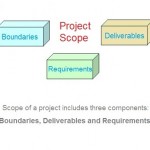
Along with doing other duties and tasks, this person needs to make sure that one of the major project documents (scope statement) is defined properly meaning in line with original goals of the project and initial expectations of key stakeholders. Let’s take a look at the definitions and examples of boundaries, deliverables and requirements. We hope this article will help project managers in understanding the key components of project scope. Please feel free to leave comments and suggestions. Thanks in advance.
Boundaries
Definition
The boundaries of a project are measurable and auditable characteristics that define what belongs to the project and what doesn’t belong to it. Project boundaries are closely linked to project objectives, they create a holistic perception of project work, and they define the content of the project in terms of expected results. A clear boundary statement helps direct the things that are applicable to those areas within the project scope.
Examples
- An organization is going to sell office equipment within The United States. It makes an agreement with a domestic US distributor. This agreement actually states a project for selling office equipment. The boundaries of this project will affect US operations only. All other locations are out of scope (that is out of the defined boundaries).
- An IT administrator considers installing a new software system on computer workstations of both Finance and Legal departments in some business organization. The boundaries of this project for installing the system extend to these two departments only. All other departments of the organization are out of scope. The administrator will install and configure the system while this person is not supposed to set up other systems within the current project.
Deliverables
Definition
A deliverable of a project is a tangible, measurable and auditable output which is expected to be gained or produced upon successful accomplishment of the whole project or its certain part. Defining project deliverables means going a long way towards setting the overall scope.
Examples
- An organization is going to train its employees in order to improve their skills and increase their productivity. This initiative can be regarded as an employee training project. Such a project will be delivered when employees step through all the stages of the training process and demonstrate higher productivity. Hence, this project has the following deliverables (or expected results produced when the project reaches success):
- Well-trained employees
- Improved skills
- Increased performance
- Implementation of a new billing system in Finance Department of some business organization can be considered a project. Then the deliverables of this project may include:
- Copies of the system are installed on all employee computers within the department
- All staff members know how to operate and use the new system.
Requirements
Definition
The requirements of a project are qualitative and quantitative interpretations of the interests and expectations of project stakeholders. Project requirements are closely linked to project objectives, budget, communications, assumptions and timelines. They are critical to achieving the project success, because incorrect, inaccurate, or excessive statement of project requirements will result in delays, productivity losses, wasted resources, or/and customer dissatisfaction.
Types and Examples
- Product requirements: they specify characteristics of the deliverables. For instance, if you are going to develop a software product, most of the requirements will be based on features of this product. These features may include interface options, the use of network capabilities (Internet, VPN, LAN), compatibility with different operating systems, etc.
- Process requirements: they define how customers interact with a product and how this product interacts with other products. For instance, if you try to describe how data gets moved during billing transactions, process requirements will describe the life cycle of billing transactions: how each transaction moves from receiving an order to invoicing and accounts receivable.